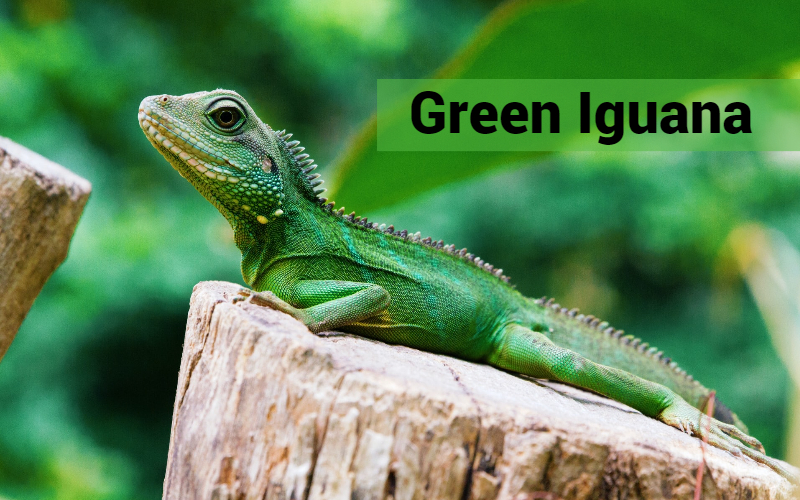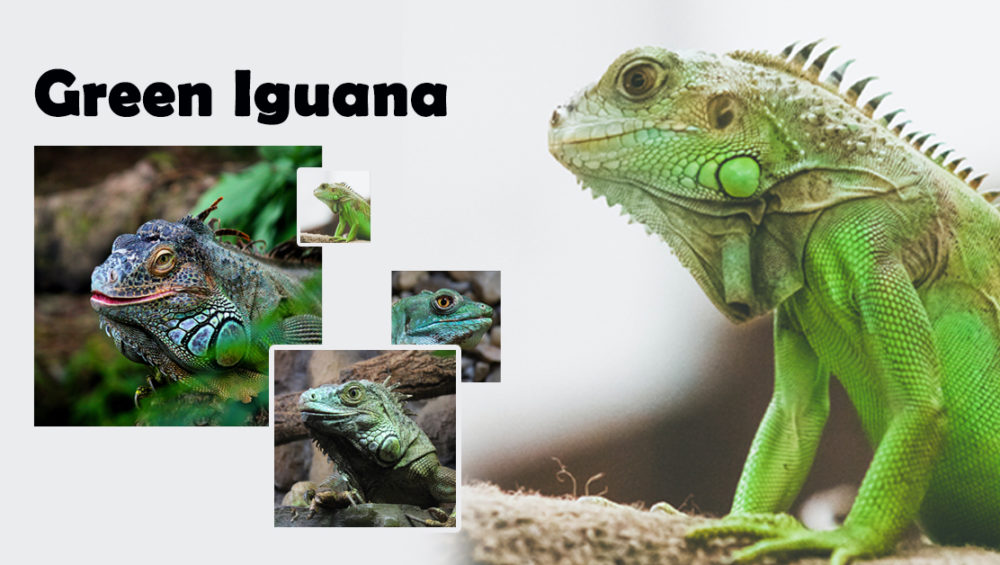Green iguanas can be found throughout North and South America’s tropical and subtropical regions. Green iguanas are found throughout Mexico, Central America, and South America, including Paraguay and Argentina. Green iguanas can be found across the Lesser Antilles, as well as the Greater Antilles and Southern Florida in recent years. Green iguanas are an invasive species in the Greater Antilles and southern Florida. Iguanas are one of the most common reptiles kept as pets. They prefer sunbathing or being exposed to ultraviolet radiation, and they eat a diet rich in leafy greens and vegetables.
What We Like About Green Iguanas:
Pros:
- In its native nations, this species is known as “palo gallino” or “bamboo chicken.”
- On top of their heads, they have a “third eye,” a photosensory organ.
- Face recognition is a capability of iguanas. This means they can figure out who looks after them.
- Hatchlings can stay together for up to a year. Males in the family group frequently guard females, a trait rarely seen in other reptiles.
Cons:
- Large, complicated enclosures with plenty of perches and room are required for iguanas.
- This lizard has unique requirements for temperature and illumination.
- It can take months for them to become accustomed to human interaction.
- During breeding seasons, males may become more aggressive.
Appearance

The name implies that Green Iguanas are only green, although this is not the case. They can actually come in a range of hues. Red, blue, green, yellow, white, black, and orange iguanas are available. Their price usually rises as the colour gets scarcer, such as yellow, white, and black. Color is greatly influenced by location and selective breeding. They shed in chunks on a regular basis, just like other lizards. This process can be aided by regular soaking, but when sufficiently hydrated, they should be able to remove the skin on their own.
Green iguanas can grow to be 6 to 7 feet long and weigh up to 20 pounds. Male green iguanas grow to be longer than female green iguanas, which rarely grow to be more than 5 feet long. Male green iguanas also have larger spikes on their backs and massive femoral pores on the underside of their back legs as they develop. Green iguanas can live for 15 to 20 years if properly cared for.
Handling
A Green Iguana can be docile and quiet in captivity if gentle socialisation is practised from a young age. If they haven’t been socialised or are in the presence of a stranger, they may exhibit defensive behaviours including hissing, biting, clawing, tail whipping, or stiffening. As hatchlings, green iguanas might be stressed. Excessive handling can exacerbate this, making it more difficult to socialise. Avoid handling your Iguana after they’ve been moved into their new enclosure. Instead, try moving the cage’s décor about to make them used to you. Start with feeding them with your hands to get a feel for how to handle them. Once they identify you with feeding, they will begin to trust you. You can begin managing trust once it has been established. For certain species, this process can take months.
Keep the following in mind when handling your Green Iguana:
· Keep their face away from yours
· Keep their tail pointing towards the ground behind you
· Brace their weight by placing your hand between their forelimbs
Captive Environment
Adult Iguanas in captivity require a vivarium measuring at least 6′ x 5′ x 4′. If extra space is available, it is best. Most people will give a fully grown adult Iguana a room in their home. 12-14 hours each day, use full spectrum 5 percent UVB illumination. Provide a shady spot with access to a cooler spot. A heat gradient in their aquarium is preferred by all reptiles. A UVB bayonet lamp for basking at one end of the tank, with a heat mat under the same side, would be ideal. Hides, branches, reptile plants/leaves, and substrate like Coconut fiber are all excellent choices. Although personal preference is important, try to adhere to wooden hides and leaves, as these creatures’ dwell in trees, and sand for substrate and caves for hides are not appropriate for their natural habitat.
Cleaning & Misting
Since green iguanas consume a lot, they will leave a lot of waste in their cage. As a result, you should remove faeces and plant detritus with a substrate shovel on a daily basis. You should also inspect their faeces during this time. Make sure there’s a good mix of dark and light urates. An imbalance between the two, or their complete absence, can indicate digestive problems. You should clean your Iguana’s cage and replace the substrate every four weeks. If you’re using live plants, make sure to carefully remove them while preserving the root structure. Soap and water should be used to scrub all surfaces. Any removable décor should be soaked in a 10 percent bleach solution to destroy microorganisms.
Lighting & temperatures
Green iguanas are native to the tropics. You’ll want to provide them with a basking area as well as a chilly place where they can adjust their body temperature. All of the lighting and heating equipment should be on one side, with the cool side on the other. Your iguana will be able to move back and forth between the different temperatures as needed. A 100–115-degree basking space should be supplied. The temperature in the rest of the enclosure can be in the 80–85-degree range. Temperatures can dip to as low as 75 degrees at night. Use a decent temperature gauge, such as a digital thermometer or a thermometer. For a baby iguana, one basking bulb is sufficient, but for an adult iguana, at least two bulbs should be placed next to each other to provide a bigger space for your iggy to heat up. Warming a large-bodied iguana takes a lot of energy. It’s great if it’s a little more spread out and not too hot in one spot.
Iguanas require UVB lighting in addition to heat to help them absorb calcium and produce vitamin D3. We must offer UVB light in the form of a special fluorescent bulb designed to create UVB rays because they do not receive natural sunlight in our homes. Heat rocks should not be used. Green iguanas have evolved a particular adaptation for basking, which allows them to absorb heat from above. They can get severely burned on a heat rock if they don’t notice it’s too hot until it’s too late.
Humidity and Water Requirements
Iguanas demand moderate to high humidity levels. Every other day, mist the vivarium. Additionally, provide a large, relatively deep-water dish for drinking and bathing. Place the water dish over half of the basking area to allow the heat to produce water vapour, which will increase humidity. As water stimulates the bowls of all reptiles, this will need to be cleaned out thoroughly every day. Also, check the water levels every time you are near your tank to make sure it hasn’t all evaporated. Also, make sure you use just lukewarm water. They might be shocked and possibly die if they come into contact with ice cold water.
Green Iguana Food
Raw natural foods purchased in a supermarket and professionally prepared “Iguana Food” can readily meet the dietary needs of green iguanas. Collard greens, turnip greens, dandelions, yellow squash, entire green beans, and other vegetables are great for your green iguana. We also give fruit on a weekly basis. Diarrhea can occur if a green iguana’s diet is high in fruit.
Small green iguanas require slightly different food preparation than adult green iguanas. When chopping raw veggies, make sure each piece is the right size for the green iguana to simply pick up and consume whole. Keep in mind that green iguanas can’t chew their food and must swallow it whole.
Green Iguana Substrate
A solid substrate must be used to avoid the possibility of your Green Iguana eating the substrate. Particulate substrates are not advised at all because they can create health issues for your Green Iguana if swallowed mistakenly. Coconut fiber, newspaper are recommended.
Coconut fiber
For most iguana owners, the coconut fiber-based substrate is a suitable option. Coconut is one of the safest substrate materials available. It clumps up around droppings and makes cleaning up a little easier for you, the owner. Coconut also has antibacterial effects. It will catch and even eliminate microorganisms from faeces. When the iguanas are young and in their large pen, coconut is a good substrate to utilise. It was made without the use of any chemicals, and it is also harmless for the environment.
Pros:
• Very natural look
• Self-cleaning and easy cleanup of droppings
• Affordable and good value
Cons:
• May attract mites and bugs over time
Newspaper
Another viable substrate choice is newspaper. Using newspapers, which are often easily available in the home, is a simple method. Three or four layers of newspaper should be used to cover the entire floor area. Daily replacement of newspaper substrates is recommended. Any spills should be cleaned up as soon as possible. Newspapers are a relatively cost-effective solution, despite their unappealing appearance.
Pros:
• Easy to replace
• Affordable
Cons:
• Wet or damp newspaper cause bacterial infection
Artificial Grass Patch
For the large region that needs to be covered with iguanas, an artificial grass patch works nicely. It is more expensive than the other products, but the benefits may be worth it to you. Iguanas can safely eat the synthetic material because it is lead-free and non-toxic even when wet. It has a natural-looking pattern that is full and comfortable to the touch. You don’t have to do anything to get it up and running. Simply place it where you want it and plonk it down. The colour won’t leak when exposed to sunshine or the UVB lights your iguana need because it’s UV resistant. The grass has drainage pores in it, making it resistant to mould caused by standing water. This also makes cleanup a breeze. This grass will last for years if no severe harm occurs.
Pros:
• Easy to use and clean
• Soft, natural feel
• Durable product to last years
• Safe and resistant to mold
Cons:
• High price
Fun facts about the green iguana
· If they are trapped, they can detach their tails and grow a new one. That’s ingenious!
· They have superb eyesight, which allows them to see prey or detect danger from afar.
· Despite being classified as omnivores, they prefer a herbivorous diet.· Green iguanas have razor-sharp teeth that can rip leaves from trees and puncture human skin.




